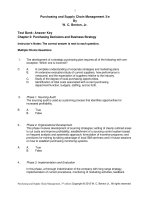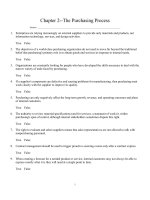Lecture Purchasing and supply chain management (3rd/e): Chapter 17 - W. C. Benton
Bạn đang xem bản rút gọn của tài liệu. Xem và tải ngay bản đầy đủ của tài liệu tại đây (788.31 KB, 16 trang )
Chapter 17:
Health Care Purchasing
and Supply Management
Purchasing and Supply Chain Management
3rd edition
Purchasing and Supply Chain Management, 3rd edition, Copyright © 2013, W. C. Benton Jr., All rights reserved.
Purchasing and Supply Chain Management 3rd edition, Copyright 2013 W.
1
Content
•
Inventory control
•
The DRG System and Operating Cost
•
Health Care Supply Chain
•
Group Purchasing Organization (GPO)
•
Opportunities in Health Care Supply Management
•
Process Overview of Capital Equipment Acquisition
2
Purchasing and Supply Chain Management, 3rd edition, Copyright © 2013, W. C. Benton Jr., All rights reserved.
The Health Care Industry
•
•
Hospitals are complex organizations providing services
including:
•
Inpatient treatment (nursing units), surgery, radiology, pharmacy,
laboratory
•
Dietary, housekeeping, physical plant engineering, administration
Outlook
•
•
Expected to grow and consume an even greater share of GNP
Challenges
•
Uncontrollable nonsalary costs and declining profits
3
Purchasing and Supply Chain Management, 3rd edition, Copyright © 2013, W. C. Benton Jr., All rights reserved.
Inventory and Health Care
•
Inventory control
•
•
An important component in supporting the objective of providing
patient care
The 2 primary functions of inventory (in the hospital
setting):
1.
To maximize supply service consistent with maximum
efficiency and optimum inventory investment
2.
To provide a cushion between the forecasted and actual
demand
4
Purchasing and Supply Chain Management, 3rd edition, Copyright © 2013, W. C. Benton Jr., All rights reserved.
Complicating Factors Unique to Health Care
•
Inaccurate demand estimations
•
Complex patterns of the length of stay and patient mix (types of
patients and diagnoses)
•
More accurate forecasts could be made by using DRG or CPP
related practices
•
•
Communication is vital between:
•
The practitioners (medical staff)
•
The supply management function
However, communication has traditionally been difficult
•
Hospitals as a set of “little fiefdoms”
5
Purchasing and Supply Chain Management, 3rd edition, Copyright © 2013, W. C. Benton Jr., All rights reserved.
Complicating Factors Unique to Health Care
(cont.)
•
Safety Stock
•
High cost of stock outs unique to healthcare
•
Classification of the stockout tolerances:
1)
Uselocation urgency
2)
Facilitylocation urgency
3)
Regionallocation urgency
4)
No urgency
6
Purchasing and Supply Chain Management, 3rd edition, Copyright © 2013, W. C. Benton Jr., All rights reserved.
Operating Cost in Hospitals
•
The DRG system
•
A reimbursement system
•
•
Flat rate reimbursement based on a patient’s diagnosis
•
•
Based on specific diagnosisrelated groups (DRG)
Regardless of the associated costs
Under the DRG system, reduction of hospital operating
cost has become extremely important
7
Purchasing and Supply Chain Management, 3rd edition, Copyright © 2013, W. C. Benton Jr., All rights reserved.
Hospital Supply
Management Trends
•
Training and education have become a key priority
•
Reduction in inventory levels is becoming less important
•
•
•
•
More of the supply managers report to VPlevel upper
management
Including physicians in the materials acquisition process
has shown to reduce costs
More hospitals are establishing a corporate supply chain
management department
Eliminating nonmoving supplies by implementing a
stockless distribution service
8
Purchasing and Supply Chain Management, 3rd edition, Copyright © 2013, W. C. Benton Jr., All rights reserved.
Health Care Supply Chain
•
Characteristics:
•
A prolonged costbased reimbursement system
•
High buyer’s switching cost and dependence on a supplier
because of many buyers and few suppliers
•
The performance criteria is based on hospital value for patients
•
There are a variety of organizations that bridge the suppliers and
the hospitals
•
•
e.g., group purchasing organization (GPO)
An oligopolistic environment with a relatively small number of
GPOs dominate the market
9
Purchasing and Supply Chain Management, 3rd edition, Copyright © 2013, W. C. Benton Jr., All rights reserved.
Group Purchasing Organization (GPO)
•
•
An organization created to leverage the purchasing
power of its member hospitals to obtain discounts from
suppliers
Current trends:
•
Approximately 96–98% of hospitals utilize GPO contracts
•
On average, 2~4 GPOs per facility
•
Annually, more than $175 billion is spent through a GPO
10
Purchasing and Supply Chain Management, 3rd edition, Copyright © 2013, W. C. Benton Jr., All rights reserved.
Money Flows Related to GPOs
11
Purchasing and Supply Chain Management, 3rd edition, Copyright © 2013, W. C. Benton Jr., All rights reserved.
Opportunities in Health Care Supply
Management (cont.)
•
•
Areas of opportunity in supply management:
•
Supply chain planning
•
Product management
•
Sourcing and contracting
•
Distribution and inventory management
•
Technology enablement
Supply management must be elevated to an integral
component of the hospital executive management team
12
Purchasing and Supply Chain Management, 3rd edition, Copyright © 2013, W. C. Benton Jr., All rights reserved.
Capital Equipment Acquisition Approval
•
Factors and Decision Rules
•
If two projects are judged to be of equal financial worth, the
project which better satisfies the following factors should be
chosen:
a)
Community need
b)
Marketability
c)
Hospital business objectives
d)
New technology
13
Purchasing and Supply Chain Management, 3rd edition, Copyright © 2013, W. C. Benton Jr., All rights reserved.
Technological Assessment Process
1.
Priorities must be set beforehand
2.
Form subcommittees (interdepartmental planning) including:
•
Medical personnel who use the equipment
•
Physicians
Make the committee tour the facility and become familiar with the
equipment on hand
3.
•
Look into the possibility of upgrading current equipment
Conduct interviews of the personnel who use the equipment
4.
•
Rank the needs within and among the departments
Enter information into a database
5.
•
Develop a comprehensive database
14
Purchasing and Supply Chain Management, 3rd edition, Copyright © 2013, W. C. Benton Jr., All rights reserved.
The Supplier Selection Process
•
The process:
Develop a list of functional specifications
1)
Each specification is to be categorized as a:
•
•
Necessary feature
•
Desirable feature
•
A characteristic that is irrelevant or even undesirable
2)
Establishing a bid list/initial base of qualified suppliers
3)
Arrange a prebid conference
4)
Receive bids
15
Purchasing and Supply Chain Management, 3rd edition, Copyright © 2013, W. C. Benton Jr., All rights reserved.
Questions?
16
Purchasing and Supply Chain Management, 3rd edition, Copyright © 2013, W. C. Benton Jr., All rights reserved.









